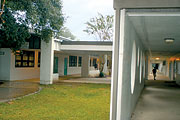
Stripping Humidity From Outdoor Air
The district was facing the need to meet the Florida version of the ASHRAE 62 ventilation code that requires the introduction of 15 cfm outdoor air per person. This represents a three-fold increase over the original code requirement of 5 cfm per person. The age of the equipment was another reason for the mechanical renovation. Some of these schools had been constructed in 1985 (coincidentally the same year that the show, MacGyver, premiered). The other, more important reason to Ventry was that students and teachers were feeling uncomfortable in a number of schools. "It really bothers me to see any classroom with heating or cooling problems. I consider every student and teacher my customer. If I can't keep my customers happy, they don't need me." Ventry is in charge of approximately 130,000 pieces of equipment and keeping 40,000 customers happy - no small task.
To address these issues, the district scheduled five schools for mechanical retrofitting during a five-year span starting in 2002. Roger Walsh, P.E., Walsh Engineering, Inc., was selected by the district to work with Ventry on developing a plan for schools within the district, including Killearn Lakes Elementary School.
‘A Mechanic's Worst Nightmare'
"The original system at Killearn Lakes was a mechanic's worst nightmare," said Ventry. "Every classroom and administrative office had its own small water source heat pump unit to cover its HVAC and IAQ needs. You can imagine the maintenance headaches with literally 60 separate units."Clearly, the first order of business was to create accessible mechanical spaces. Walsh and Ventry cleverly devised a plan to construct a mezzanine floor above each of the school's single-story wings. The TotalAire™ unit from Desert Aire features a single-side access that fit perfectly into this new design. Key to the mechanical solution of achieving the outdoor air code requirement was the need to control the level of humidity being introduced into the buildings.
"In Northern Florida, we have plenty of humidity, and temperatures that can range from over 100°F down to 20°," stated Walsh. "If the humidity isn't controlled, you've just opened yourself up to perfect conditions for bacteria and toxic mold."
To handle the humidity challenge - or more correctly, the dehumidification need -Walsh worked with engineers from Applied Mechanical Equipment to present to Ventry the idea of using Desert Aire Q-Pumps™ combined with TotalAire 5- to 20-ton dehumidifiers each equipped with an enthalpy wheel to maximize the sensible and latent heat recovery. "It was imperative that we have everything: One hundred percent outdoor air, without the need for a separate auxiliary heat source such as gas, and accurate leaving air temperature in both the dehumidification and heating modes," Walsh stated.
Skepticism Turns To ‘A-Ha'
After becoming comfortable with Desert Aire's approach, Ventry requested detailed technical information from Desert Aire and studied the TotalAire unit's control logic. Then, the MacGyver in Ventry really kicked in. "I wanted to make full use of our existing controllers, so I wrote my own software program to make sure our controllers would match the Desert Aire controller requirements."Also of key importance to Ventry was the fact that the new system, with its higher cooling load requirement, was engineered within the existing electrical power system in each building. This was possible because of the efficient operation and energy recovery characteristics of the Q-Pump unit. "The costs would have been considerable if we had needed electrical system upgrading to deal with the increased load," Walsh said.
The new system at Killearn Lakes has been in place since October 2002 - long enough for Ventry to assess its performance. "I'm very pleased. The Desert Aire system has reduced our maintenance costs substantially and has delivered on everything promised."ES
